Ceremonies Prior to the Wedding Day
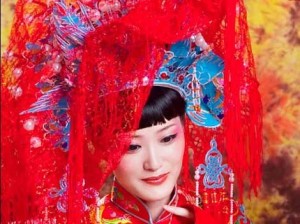
Retreating to the Cock Loft
As the wedding day nears, the bride-to-be lives in seclusion in a separate part of the house with her closest friends. At this time, the young women sing laments, mourning the bride’s separation from her family and cursing the go-between for the marriage as well as the groom’s family and even the girl’s own parents. As this extended sleepover often takes place in the cock loft and the bride usually stays here prior to the wedding day, her emergence is sometimes referred to as “coming out of the cock loft.”
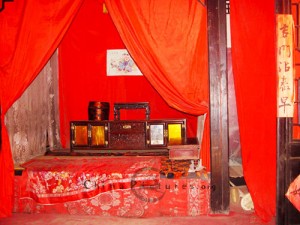 Installing the Bridal Bed
Installing the Bridal Bed
On the day before the wedding, the bridal bed is set up at an auspicious hour. This ceremony involves the participation of a “good luck” man and woman, usually a couple with many children who have been married for a long time. The couple are invited to install a newly-bought bed, which is actually is just a ceremonial moving, for the bed is already in place even before the ceremony begins. The bed is scattered with red dates, oranges, lotus seeds, peanuts, pomegranates and other fruits, as a symbol of abundance. Children are invited to stay on the bed and scramble for the fruits, as a symbol of fertility—the more, the merrier.
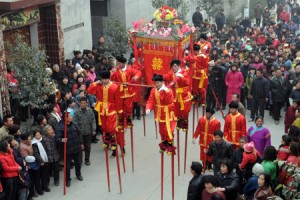
Ceremonies on the Wedding Day
Two very important ceremonies—the bride’s “Hair Dressing” Ritual of the bride and the groom’s “Capping” Ritual of the groom both symbolize their initiation into adulthood. The color red, which symbolizes joy, pervades much of the rituals along with other elements that make these ceremonies essential in the wedding preparations.
The “Hair Dressing” Ritual
At dawn on her wedding day (or the night before), the bride bathes in water infused with pomelo, a variety of grapefruit, to 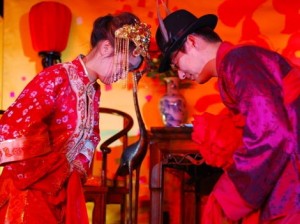 cleanse her of evil influences as well as to soften her skin. After the infused bath, she puts on new underclothes and sits before lit candles imprinted with symbols of the dragon and the phoenix. To oversee the bridal preparations, a “good luck” woman attends to the bride, saying auspicious words while dressing the bride’s hair in the style of a married woman. After the hair dressing ritual, the bride is carried to the main hall on the back of the ‘good luck’ woman or her most senior sister-in-law. She will be asked to wear a jacket and skirt with a pair of red shoes. The bride’s face will be covered with either a red silk veil or a ‘curtain’ of tassels hanging from the Phoenix crown. The bride then bows and pays respect to her parents and to the ancestral tablets and will be waiting for the arrival of the bridal procession from the groom’s house.
cleanse her of evil influences as well as to soften her skin. After the infused bath, she puts on new underclothes and sits before lit candles imprinted with symbols of the dragon and the phoenix. To oversee the bridal preparations, a “good luck” woman attends to the bride, saying auspicious words while dressing the bride’s hair in the style of a married woman. After the hair dressing ritual, the bride is carried to the main hall on the back of the ‘good luck’ woman or her most senior sister-in-law. She will be asked to wear a jacket and skirt with a pair of red shoes. The bride’s face will be covered with either a red silk veil or a ‘curtain’ of tassels hanging from the Phoenix crown. The bride then bows and pays respect to her parents and to the ancestral tablets and will be waiting for the arrival of the bridal procession from the groom’s house.
The “Capping” Ritual
The groom, dressed in a long gown, red shoes and a red silk sash with a silk ball on his shoulder, kneels at the family altar while his father places a cap decorated with cypress leaves on his head. After bowing before the tablets of Heaven and Earth and his ancestors, then to his parents and the assembled family members, the groom’s father removes the silk ball from the sash and places it on top of the bridal sedan chair.
The Procession of Obtaining the Bride
After the two rituals, the procession from the groom’s home to obtain the bride commences, marked by the lighting of firecrackers 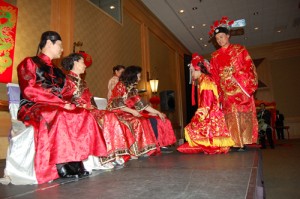 and the banging of the gongs and drums. The groom leads the procession accompanied by a child, symbolizing his future sons, and the bridal sedan chair followed by attendants with lanterns and banners, musicians, and a ‘dancing’ lion or unicorn. Upon arrival at the bride’s house, the groom’s party is met by the bride’s friends, who would not ‘surrender ’the bride until the groom’s representative hands out enough red packets of money, called ang pau, involving some good-natured haggling. Some cases will have the with the bride’s family sharing dinner with the groom, and they will hand him a pair of chopsticks and two wine goblets wrapped in red paper, symbolic of his acceptance in the family. The customs will vary per region. In some places, the groom will partake of sweet longan tea, two hard-boiled eggs in syrup and transparent noodles. In other places the groom will have some soup with a soft-boiled egg, and he would be expected to break the yolk as a symbol of breaking his bride’s ties to her family.
and the banging of the gongs and drums. The groom leads the procession accompanied by a child, symbolizing his future sons, and the bridal sedan chair followed by attendants with lanterns and banners, musicians, and a ‘dancing’ lion or unicorn. Upon arrival at the bride’s house, the groom’s party is met by the bride’s friends, who would not ‘surrender ’the bride until the groom’s representative hands out enough red packets of money, called ang pau, involving some good-natured haggling. Some cases will have the with the bride’s family sharing dinner with the groom, and they will hand him a pair of chopsticks and two wine goblets wrapped in red paper, symbolic of his acceptance in the family. The customs will vary per region. In some places, the groom will partake of sweet longan tea, two hard-boiled eggs in syrup and transparent noodles. In other places the groom will have some soup with a soft-boiled egg, and he would be expected to break the yolk as a symbol of breaking his bride’s ties to her family.
The Bride’s Journey to the Groom’s House
After the bride is claimed, she will be carried back to the groom’s house in a sedan chair by the dajin or “good luck” woman, who is employed by her family to take care of her. employed by the bride’s family to look after the bride, The other variations of this ritual include shielding the bride with a parasol while another attendant tosses rice and other beans as a symbol of fertility at the sedan chair. In other cases, the bride is actually contained in a wooden ‘cage’, and her feet padlocked, but this practice is already rare in these modern times. During the journey, firecrackers are lighted to frighten away evil spirits, as the bride sits in her sedan chair. The bridal sedan chair is decorated with a sieve, called shai-tse, which would strain out evil, and a metallic mirror, king, 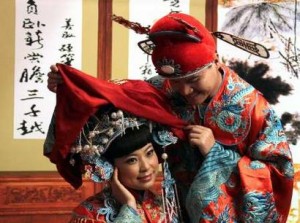 which would reflect light, to protect the bride from evil influence. The sedan chair itself is covered with curtains so that the bride may avoid seeing anything unlucky signs, such as a widow, a well, or even a cat. The bride also has special mirror attached to her garment, which will only be removed when she is already safely seated on the marriage bed.
which would reflect light, to protect the bride from evil influence. The sedan chair itself is covered with curtains so that the bride may avoid seeing anything unlucky signs, such as a widow, a well, or even a cat. The bride also has special mirror attached to her garment, which will only be removed when she is already safely seated on the marriage bed.
The Wedding
The Chinese wedding culminates, ironically, in a simple ceremony in contrast to elaborate preparations, the wedding ceremony. The bride and groom pay homage to Heaven and Earth at the family altar, honoring the the family ancestors and the Kitchen God, Tsao-Chün. The couple will offer the groom’s parents some tea with two lotus seeds or two red dates in the cup.
Then the bride and groom will bow to each other, concluding the ceremony. In some regions the couples may also drink wine from the same goblet, eat sugar molded in the form of a rooster, and share the wedding dinner.
The Nuptial Chamber
The Wedding Banquets


